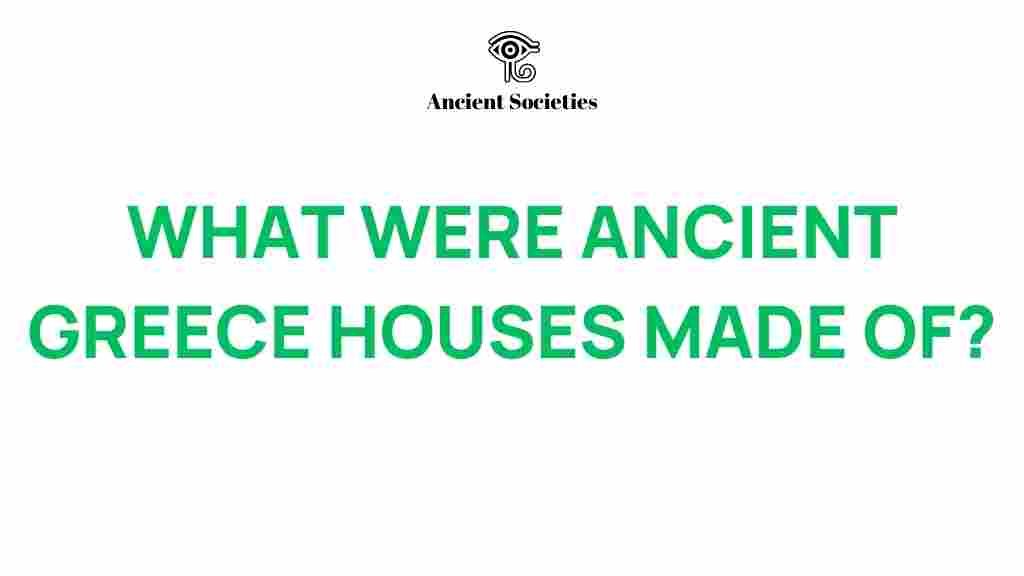Unveiling the Secrets of Ancient Greek Homes: What Were They Made Of?
Ancient Greece is often celebrated for its profound influence on Western civilization, particularly in the realms of philosophy, democracy, and the arts. However, one aspect that remains less explored yet equally fascinating is the architecture and construction of homes in this remarkable society. This article delves into the building materials and techniques used in ancient Greek homes, shedding light on the daily life, culture, and societal structures of the time.
The Importance of Homes in Ancient Greece
Homes in Ancient Greece were more than just shelters; they were a reflection of the society and culture of the time. They served as family centers and were often designed to accommodate both daily life and communal activities. Understanding the construction and materials used in these homes provides unique insights into the history and culture of Ancient Greece.
Building Materials Used in Ancient Greek Homes
The construction of homes in Ancient Greece relied heavily on locally available materials. Here are some of the primary building materials:
- Stone: Many homes, especially those of the wealthy, were constructed using large blocks of limestone or marble. These materials were both durable and aesthetically pleasing.
- Clay: Clay was a common material used for making bricks and pottery. Mud bricks were often used in less affluent homes.
- Wood: Timber was utilized for structural elements, such as beams and roofs, though it was less common due to susceptibility to decay and fire.
- Thatch: In rural areas, thatch made from straw or reeds was often used for roofing.
Architectural Styles and Their Evolution
Ancient Greek architecture can be classified into several styles, with each reflecting the cultural and historical context of its time. The main styles included:
- Doric: The simplest and most robust style, characterized by sturdy columns without bases. It was prevalent in the early classical period.
- Ionic: More slender and elegant than Doric columns, featuring scroll-like capitals. This style became popular in the later classical period.
- Corinthian: The most ornate style, with elaborate capitals adorned with acanthus leaves. This style emerged in the Hellenistic period.
Step-by-Step Construction Process of Ancient Greek Homes
The construction of homes in Ancient Greece followed a systematic process, which can be outlined in several key stages:
1. Site Selection
Choosing the right location was crucial. Homes were often built on elevated ground to avoid flooding and to provide a view of the surrounding area.
2. Foundation Laying
A strong foundation was essential for stability. Builders dug deep trenches and filled them with stones or gravel to create a solid base.
3. Construction of Walls
Walls were built using either stone or mud bricks. In more affluent homes, large stone blocks were carefully fitted together without mortar, while poorer homes often used mud bricks.
4. Roof Installation
Roofs were typically slanted to allow rainwater to run off. Thatch or wooden beams covered with clay tiles were common roofing materials.
5. Interior Layout
Homes were designed with a central courtyard that provided light and ventilation. Rooms were arranged around this courtyard, often including areas for cooking, sleeping, and storage.
Daily Life in Ancient Greek Homes
The interior of an ancient Greek home varied significantly based on the wealth and status of the family. Daily life was structured around several key activities:
- Cooking: The kitchen was usually located near the entrance, with a simple hearth for cooking meals.
- Socializing: The courtyard served as a space for family gatherings and social interactions.
- Crafts and Work: Many families engaged in artisanal activities, often within the home.
Archaeological Insights into Ancient Greek Homes
Archaeology has uncovered a wealth of information about ancient Greek homes. Excavations at sites like Pompeii have revealed stunning examples of domestic architecture, providing insights into the daily lives of their inhabitants. The layout of homes, the artifacts found within, and the construction techniques used all contribute to our understanding of ancient Greek society.
Troubleshooting Common Misconceptions
While studying ancient Greek homes, several misconceptions often arise:
- Misconception 1: All ancient Greek homes were the same.
Reality: There was significant variation based on social status, regional differences, and available materials. - Misconception 2: Greek homes were all open and airy.
Reality: Many homes, especially in urban areas, were quite compact and designed for privacy. - Misconception 3: Women had no role in the household.
Reality: Women managed the home and were integral to its operations, especially in poorer families.
The Cultural Significance of Home in Ancient Greece
Homes in Ancient Greece were not just physical spaces; they were central to the cultural identity and values of Greek society. The concept of oikos, meaning household, encompassed family, property, and the social roles that defined relationships within the home. This concept was crucial in understanding the social fabric of ancient Greek culture.
Conclusion: The Legacy of Ancient Greek Homes
In conclusion, the architecture and building materials of ancient Greek homes provide a fascinating glimpse into the daily life, culture, and society of this influential civilization. By unraveling the secrets of these structures, we not only appreciate the ingenuity of ancient builders but also gain insights into the significant role that homes played in shaping the identities of families and communities. The study of ancient Greek homes continues to offer valuable lessons about sustainability, community, and the importance of the domestic sphere in human life.
For more information on ancient Greek culture and its lasting impacts, visit this resource.
This article is in the category Archaeology and created by AncientSocieties Team
